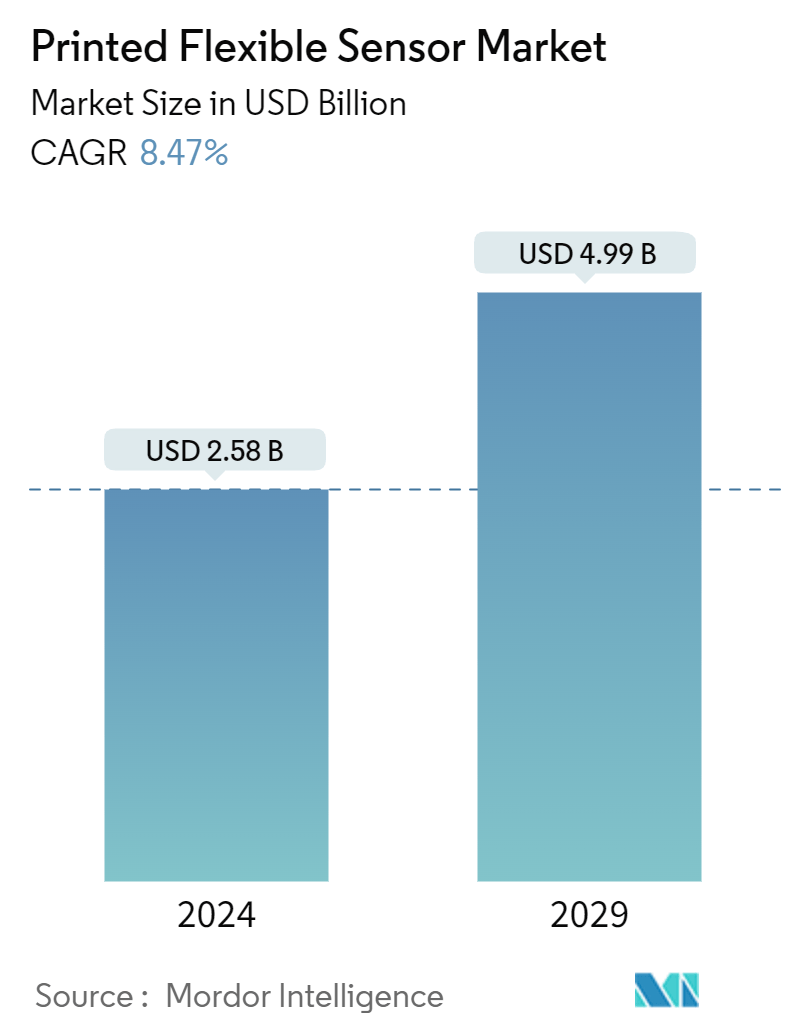Market Size of Printed Flexible Sensor Industry

| Study Period | 2019 - 2029 |
| Market Size (2024) | USD 2.58 Billion |
| Market Size (2029) | USD 4.99 Billion |
| CAGR (2024 - 2029) | 8.47 % |
| Fastest Growing Market | Asia Pacific |
| Largest Market | North America |
| Market Concentration | Medium |
Major Players
*Disclaimer: Major Players sorted in no particular order |
Printed Flexible Sensor Market Analysis
The Printed Flexible Sensor Market size is estimated at USD 2.58 billion in 2024, and is expected to reach USD 4.99 billion by 2029, growing at a CAGR of 8.47% during the forecast period (2024-2029).
- Printed and flexible electronics use advanced electronic printing methods to create devices such as sensors on different substrates. The inks, substrate, and printing techniques create a unique technology, allowing greater flexibility, lower cost of ownership, and speed.
- In recent decades, the development of organic semiconductors, conductive polymers, amorphous silicon, and conductive inks has led to huge strides toward processability and flexibility. Thus, these materials have become the base for the development of printed and flexible electronic devices, such as sensors, in applications that require rolling, bending, folding, and stretching, among other properties that conventional electronics find hard to fulfill.
- A significant driving factor behind the market's growth is the progression in demand for energy-efficient, thin, and flexible consumer electronics products. The trend of miniaturization is becoming prevalent across various end-user industries, such as consumer electronics, medical devices, and automotive, which is another major factor expected to positively influence the growth of the market. In the next few years, the prices of printed and flexible sensors are anticipated to decline owing to further development in material types and advancements in manufacturing processes, which are also likely to enhance the market's growth.
- Over the years, the penetration of consumer electronic products has increased significantly. Urbanization, changing lifestyles, the growing demand for convenience products, and technological advancement bringing the price of consumer products down are among the major factors driving this growth.
- With the development of disciplines such as material and control science and communication technology, there has been a series of breakthroughs in flexible sensors. These sensors have achieved multi-directional information acquisition capabilities and the ability to maintain excellent performance in complex environments, with varying degrees of sensitivity, detection ranges, and minimum detection values.
- Additionally, the development of adaptive, implantable, and degradable materials and the emergence of self-powered bio-cells have led to the emergence of a wide range of flexible and printed sensor devices. Textile-based wearable activity sensors such as pressure and strain sensors were developed to monitor various health-related biometric parameters due to their unique properties and portability.
- Furthermore, the market players frequently develop new products to expand their reach into new markets. For instance, in February 2023, Brewer Science Inc. announced the launch of hybrid printed sensors for efficient, real-time water quality monitoring to measure lead, nitrate, and pH at LOPEC in Germany. These sensors are made possible by combining printed electronics with next-generation materials. The result is a real-time continuous monitoring platform that can leverage multi-sensor arrays and associated multi-faceted sensor solutions.
Printed Flexible Sensor Industry Segmentation
Sensors that are printed on flexible substrates signify a growing market. While some may consist of a very simple structure with only a few electrodes, others are much more complicated and need the deposition of many layers. They have in common the ability to be printed on plastic substrates, which offers them benefits in terms of mechanical flexibility, thinness, and weight decrease.
The printed flexible sensor market is segmented by type (biosensor, touch sensor, photodetectors, temperature sensor, pressure sensor, and other types), end-user industry (automotive, consumer electronics, medical and healthcare, defense and aerospace, and other end-user industries), and geography (North America, Europe, Asia-Pacific, Latin America, and the Middle East and Africa). The report offers the market sizes and forecasts for all the above segments in value terms (USD).
| Type | |
| Biosensor | |
| Touch Sensor | |
| Photodetectors | |
| Temperature Sensor | |
| Pressure Sensor | |
| Other Types |
| End-user Industry | |
| Automotive | |
| Consumer Electronics | |
| Medical and Healthcare | |
| Defense and Aerospace | |
| Other End-user Industries |
| Geography*** | |
| North America | |
| Europe | |
| Asia | |
| Australia and New Zealand | |
| Latin America | |
| Middle East and Africa |
Printed Flexible Sensor Market Size Summary
The printed and flexible sensor market is poised for significant growth, driven by advancements in electronic printing methods and materials such as organic semiconductors and conductive inks. These technologies enable the creation of sensors on various substrates, offering flexibility, cost-effectiveness, and rapid production. The increasing demand for energy-efficient and miniaturized consumer electronics, along with the trend towards urbanization and technological advancements, is propelling the market forward. The Asia-Pacific region, in particular, is witnessing a surge in demand due to the growing adoption of flexible displays and IoT applications. The market is characterized by a few dominant players who are leveraging strategic collaborations and innovations to expand their global presence and enhance profitability.
In the medical and healthcare sector, printed and flexible sensors are becoming integral due to their ability to monitor physiological conditions through electronic skin patches and other applications. These sensors provide valuable health data, facilitating immediate diagnostics and monitoring. The eco-friendly nature and adaptability of these sensors make them suitable for various medical devices, further driving their adoption. The market is expected to see increased demand for biosensors and temperature sensors, which play crucial roles in health monitoring and medication management. Recent developments, such as hybrid printed sensors for real-time water quality monitoring and collaborations for next-generation fingerprint solutions, highlight the ongoing innovation and expansion within the industry.
Printed Flexible Sensor Market Size - Table of Contents
-
1. MARKET INSIGHTS
-
1.1 Market Overview
-
1.2 Industry Value Chain Analysis
-
1.3 Industry Attractiveness - Porter's Five Forces Analysis
-
1.3.1 Threat of New Entrants
-
1.3.2 Bargaining Power of Buyers/Consumers
-
1.3.3 Bargaining Power of Suppliers
-
1.3.4 Threat of Substitute Products
-
1.3.5 Intensity of Competitive Rivalry
-
-
1.4 Impact of COVID-19 Aftereffects and Other Macroeconomic Factors on the Market
-
-
2. MARKET SEGMENTATION
-
2.1 Type
-
2.1.1 Biosensor
-
2.1.2 Touch Sensor
-
2.1.3 Photodetectors
-
2.1.4 Temperature Sensor
-
2.1.5 Pressure Sensor
-
2.1.6 Other Types
-
-
2.2 End-user Industry
-
2.2.1 Automotive
-
2.2.2 Consumer Electronics
-
2.2.3 Medical and Healthcare
-
2.2.4 Defense and Aerospace
-
2.2.5 Other End-user Industries
-
-
2.3 Geography***
-
2.3.1 North America
-
2.3.2 Europe
-
2.3.3 Asia
-
2.3.4 Australia and New Zealand
-
2.3.5 Latin America
-
2.3.6 Middle East and Africa
-
-
Printed Flexible Sensor Market Size FAQs
How big is the Printed Flexible Sensor Market?
The Printed Flexible Sensor Market size is expected to reach USD 2.58 billion in 2024 and grow at a CAGR of 8.47% to reach USD 4.99 billion by 2029.
What is the current Printed Flexible Sensor Market size?
In 2024, the Printed Flexible Sensor Market size is expected to reach USD 2.58 billion.

